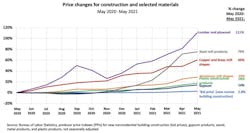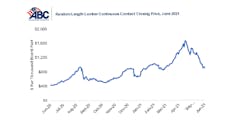Price Check: Recovery Grappling With Inflation Fears
The wild ride that the world economy has been on since the start of the Coronavirus pandemic just five-plus quarters ago as been nothing short of breathtaking. Here in the U.S., now that the darkest and most frightening days of the global public health crisis finally seem to be behind us, new economic fears have emerged in recent months to unsettle us anew.
And it doesn't seem fair, frankly. After more than a year of emotionally wrenching sacrifice, doubt, shock, sadness, joy and relief, both at home and at work, the last thing our shaken nation wants to worry about is... inflation.
But there it is.
This year, as the U.S. economy has tried to roar back into its athletic routine, inflation has kept it from sticking the landing. (Yes, that was a nod to the upcoming Summer Olympics.)
"Our economy is like a sleeping bear -- when it comes out of hibernating, it is hungry," said Jay Timmons, President & CEO of the National Association of Manufacturers (NAM), speaking June 28 at the summer meeting of the American Boiler Manufacturers Association (ABMA) in Bonita Springs FL. "It is amazing where we are today as opposed to 15 months ago... But intense demand is tending to drive up prices and our members have listed the rising cost of raw materials now as their top challenge... Inflation is not a kind master and it can be very debilitating to everyone."
Indeed, rising material prices and worker shortages have made for an unkind combination so far this year.
“The weight of higher material prices and a lack of skilled labor are having a direct and notable influence on residential construction activity,” said Richard Branch, Chief Economist for Dodge Data & Analytics. “While feeling similar effects, the nonresidential sector continues its modest recovery off the lows of last summer. There are enough projects in the planning pipeline to suggest this trend should continue into next year, but higher material prices will result in longer lead times to groundbreaking and more temperate improvements in nonresidential starts.”
Even so, many more architects and engineers are smiling this summer, as opposed to last.
"Concern over rising inflation and ongoing supply chain disruptions, as well as emerging labor shortages, could dampen the emerging construction recovery,” conceded Kermit Baker, Chief Economist of the American Institute of Architects (AIA). "[But] despite ballooning costs for construction materials and delivery delays, design activity is roaring back as more and more places reopen."
- UPDATE: The nonpartisan Congressional Budget Office (CBO) reported July 1 that it was now projecting U.S. Gross Domestic Product (GDP) to grow 6.7% by the end of 2021. That would be the largest such yearly increase since 1984.
In fact, the latest AIA Architecture Billings Index (ABI) score for May rose to 58.5 compared to 57.9 in April (any score above 50 indicates an increase). May’s score is one of the highest in the index’s 25-year history, noted Baker.
Still, contractors feel particularly squeezed by current conditions. So they are ringing alarm bells and clamoring for government action, especially for resolution of a five-year-old tariffs dispute with Canada that has diminished the overall lumber supply in the U.S.
"Although the overall economy has strengthened significantly in the past few months and appears to be headed for further growth, the construction industry has experienced a much more uneven recovery," writes Ken Simonson, chief economist at Associated General Contractors of America (AGC), in the group's newly published Construction Inflation Alert. "Lagging demand for numerous types of nonresidential construction is keeping many contractors from passing on their added costs. This combination of steeply rising costs and nearly stable bid prices threatens to push some firms out of business and keep the industryʼs unemployment rate unacceptably high."
The new, eight-page report is already AGC's third national Construction Inflation Alert this year. In the latest update, Simonson recommends that contractors be as candid and up front with project owners as soon as possible, and as often as necessary.
"While contractors cannot unclog ports or rescind tariffs, they can provide project owners with timely and credible third-party information about changes in relevant material costs and supply chain snarls that may impact the cost and completion time for a project that is underway or for which a bid has already been submitted," he writes. "Owners can authorize appropriate adjustments to design, completion date, and payments to accommodate or work around these impediments. Nobody welcomes a higher bill, but the alternative of having a contractor go out of business because of impossible costs or timing is likely to be worse for many owners."
Simonson adds that "owners and bidders also may want to consider price-adjustment clauses that would protect both parties from unanticipated swings in materials prices. Such contract terms can enable the contractor to build in a smaller contingency to its bid, while providing the owner an opportunity to share in any savings from downward price movements (which are likely at some point, particularly for long-duration projects). The ConsensusDocs set of contract documents is one source of industry-standard model language for such terms and its website includes a price escalation resource center."
Of note, the ConsensusDocs are backed by 41 industry groups, including MCAA, PHCC, CFMA, CSI, and both AGC and rival Associated Builders and Contractors (ABC). For its part, ABC sees some hope for the market correcting itself sooner than later.
“The cure for high prices is high prices, which decrease quantity demanded in the short-term, increase quantity supplied and incentivize suppliers and sellers to bolster capacity in the long-term,” said ABC Chief Economist Anirban Basu. “Already there is evidence that output is on the rise, which has helped to trigger the price moderation process. That said, input prices will remain elevated by historical standards for at least several more months.”
Last week, ABC released the following statement:
The elevated price of softwood lumber, a major talking point during much of the pandemic, appears to have peaked in early May at more than $1,700 per thousand board feet. As of June 23, the price has fallen below $900 per board feet, down about 49% in less than two months. That’s still an unusually lofty price by historic standards—prices remain almost twice as high as in February 2020—but the trend is very much in the right direction. Builders who had been hoarding lumber have now begun to sell from their own inventory, other builders have delayed lumber purchases in anticipation of lower prices, and sawmill operators have been adding shifts and expanding capacity, all of which puts downward pressure on prices.
Copper prices, which have nearly doubled since the pandemic began, have fallen modestly in recent weeks as China released metal reserves and the Federal Reserve indicated a more hawkish stance on future rate increases. Further construction materials price dips are likely, particularly for metals like aluminum and zinc. Steel prices, with demand elevated and China curbing production, have leveled off since late May but remain nearly three times higher than pre-pandemic levels.
Regarding the Fed, Nobel laureate economist Paul Krugman is even more reassuring. His June 21 column in The New York Times was entitled, The Week Inflation Panic Died. In it, he observed, "The Fed’s view has been that this episode, like the inflation blip of 2010-11, will soon be over. And it’s now looking as if the Fed was right. Lumber prices have plunged in recent weeks. Prices of industrial metals like copper are coming down. Prices of used cars are still very high, but their surge has stalled and they may have peaked."
He concluded, "The vehemence of the inflation rhetoric has been wildly disproportionate to the actual risks — and those risks now seem even smaller than they did a few weeks ago."
Here's hoping that measured confidence holds up. After an exhausting and anxious year — for virtually every U.S. household and business — all any of us really want at this point is stability. Twelve months ago, we were also facing a very uncertain summer. But 300 million vaccinations later, America is in a vastly different place this Fourth of July. Granted, the national economic stage may be cluttered with more obstacles than we would like now, but it is still set for an epic recovery.
##########
About the Author
Rob McManamy
Editor in Chief
An industry reporter and editor since 1987, McManamy joined HPAC Engineering in September 2017, after three years with BuiltWorlds.com, a Chicago-based media startup focused on tech innovation in the built environment. He has been covering design and construction issues for more than 30 years, having started at Engineering News-Record (ENR) in New York, before becoming its Midwest Bureau Chief in 1990. In 1998, McManamy was named Editor-in-Chief of Design-Build magazine, where he served for four years. He subsequently worked as an editor and freelance writer for Building Design + Construction and Public Works magazines.
A native of Bronx, NY, he is a graduate of both the University of Virginia, and The John Marshall Law School in Chicago.
Contact him at [email protected].



